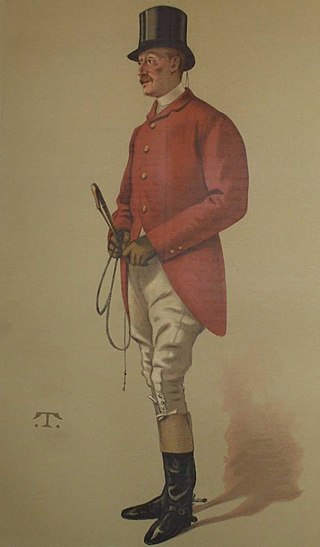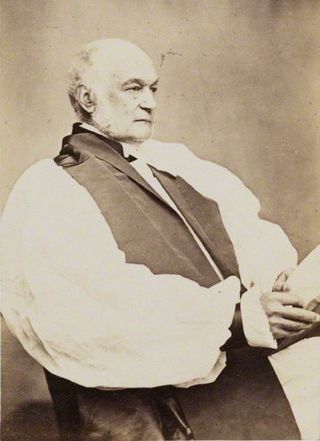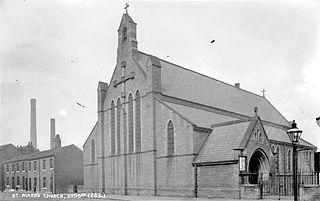Related Research Articles

Captain William GeorgeMiddleton was a noted British horseman, officer of the Royal Lancers, and equerry to Lord Spencer, Lord Lieutenant of Ireland. He was described as "one of the best riders to hounds that ever lived, an amusing dare-devil and very good company."

Henry Campbell Bruce, 2nd Baron Aberdare,, styled The Honourable from 1873 to 1895, was a British soldier and peer.

George Moberly was an English cleric who was headmaster of Winchester College, and then served as Bishop of Salisbury from 1869 until his death.

John Henry Whitley, often known as J. H. Whitley, was a British politician and Georgist. He was the final Liberal to serve as Speaker of the House of Commons, a role he held from 1921 to 1928.
Frederick Levi Attenborough was an English academic and principal of University College, Leicester.

Sir George William Harriman CBE was a leading figure in the British motor industry in the 1960s.
Granville Boyle Coghlan was an educationalist and an early twentieth century rugby union international who is known as one of the "lost lions" due to his participation on the 1927 British Lions tour to Argentina which, although retrospectively recognised as a Lions tour, did not confer test status on any of the four encounters with the Argentina national rugby union team.
Edward Alexander Wyon was a London architect and poet, descended from the Wyon family of engravers. His only known building is St John the Evangelist Church in Hollington, Hastings in East Sussex. His posthumous publication, A Memorial Volume of Poems (1874), continues to be reprinted in the 21st century. He died in Hastings prior to his thirtieth birthday.
Petley Price was a rugby union international who represented England on three occasions from 1877 to 1878.

Thomas Edward Wilkinson (1837−1914), known as Edward Wilkinson, was an Anglican bishop, legionnaire and travel writer in the late 19th and early 20th centuries. The sixth child of a gentleman farmer, he was born at Walsham Hall, Walsham le Willows, Suffolk. Before he was ordained, he joined the French Foreign Legion and travelled around Europe.
Charlotte Johnson Wahl was a British artist. She was the mother of Boris Johnson, the former prime minister of the United Kingdom, as well as the journalist Rachel Johnson and the politician Jo Johnson.
Henry Grierson was an English cricketer, barrister and author, who played cricket for Bedfordshire between 1909 and 1921 and for Cambridge University from 1911 to 1912.
Mary Bonham-Christie called "the Demon of Brownsea", was the reclusive owner of Brownsea Island in Poole Harbour, Dorset from 1927 until her death in 1961.

Canon Sydney Robert Elliston MA was a journalist, vicar, and canon of Ripon Cathedral. Two of his brothers were William Rowley Elliston and George Elliston MP. He was involved with the formation of the Ripon Diocesan Board of Finance in 1913, and was its secretary from 1914 to 1935. At his funeral it was said of him that, "The diocese of Ripon owed a great debt to the work of Canon Elliston in laying down sound principles of Church finance." While looking after the finances of Ripon diocese, he was at the same time vicar of one of north-east England's Barber churches: the Church of St Thomas the Apostle, Killinghall (1880), designed by William Swinden Barber.

The former St Mark's Church, Old Leeds Road, Huddersfield, was an Anglican parish church in West Yorkshire, England. It was previously known as St Mark's, Leeds Road, before the road name was changed. This building was designed in 1886 by William Swinden Barber when the parish of St Peter's was split and a new building was required to accommodate a growing congregation. It was opened in 1887. Among the vicars posted in this benefice were the very popular Canon Percy Holbrook, the notoriously unfortunate Reverend Jonas Pilling who was involved in a standoff with his congregation for many years, the sociable Reverend Robert Alfred Humble who died in mysterious circumstances, and the eloquent preacher Reverend Joseph Miller, who had previously been a Congregational minister. The building was sold by the Church of England in 2001, and it has been converted into a block of offices.

Benjamin Payler, , was a sculptor, stone and marble mason. He was apprenticed to Catherine Mawer, alongside fellow apprentices Matthew Taylor and Catherine's son Charles Mawer. He formed a business partnership at 50 Great George Street with Charles Mawer in 1881. There is no known record of Charles after that. Payler continued to run the business there under his own name. In his day, he was noted for his 1871 bust of Henry Richardson, the first Mayor of Barnsley, his keystone heads on the 1874 Queen's Hotel in the same town, and his architectural sculpture on George Corson's 1881 School Board offices, Leeds. Payler was a member of the Mawer Group, which included the above-mentioned sculptors, plus William Ingle.
Benjamin Burstall was a sculptor, architectural sculptor and stone carver, based in Leeds, West Riding of Yorkshire, England.
Felicia Dorothea Kate Dover was an English woman who was tried for murder and convicted of manslaughter in 1882 following the death of Thomas Skinner from arsenic poisoning. She was trained as an artist at Sheffield School of Art and was skilled in drawing flowers. She was popularly known as the Queen of Heeley due to her artistic interests and her standard of dress.

Edith Elise Cadogan Cowper was a prolific and popular author of adventure stories for girls. She married yachtsman and fellow writer Frank Cowper and had eight children by him before the marriage fell apart.

William John Seward Webber was an English sculptor who created civic statuary, and busts of national heroes and local worthies, in marble. He sculpted the statue of Queen Victoria for the Jubilee Monument in Harrogate, North Riding of Yorkshire, England in 1887. An early success was his Warrior and Wounded Youth group of 1878, executed while he was still a student. His busts include portraits of the Duke of Clarence, John Charles Dollman, Henry Phillpotts, John Bowring, John Ruskin, Richard Jefferies, Alfred, Lord Tennyson, Charles Darwin, Walter Scott, Thomas Carlyle, Robert Burns and Thomas Holroyd.
References
- 1 2 J.E. Paul Profile on scrum.com
- ↑ "Index entry". FreeBMD. ONS. Retrieved 25 March 2011.
- ↑ Census Returns of England and Wales, 1861. Kew, Surrey, England, Class: RG9; Piece: 1780; Folio: 41; Page: 30; GSU roll: 542867.
- ↑ Rugby School; Michell, Arthur Tompson, Rugby School register, Volume: 2, 1901-1904
- ↑ Great Britain. India Office, The India list and India Office list, Page 584, (Harrison and Sons)
- ↑ "Index entry". FreeBMD. ONS. Retrieved 25 March 2011.
- ↑ "Index entry". FreeBMD. ONS. Retrieved 25 March 2011.